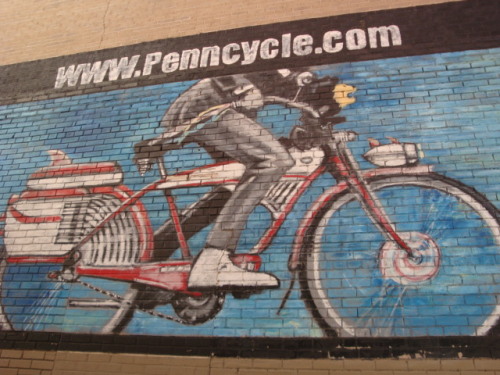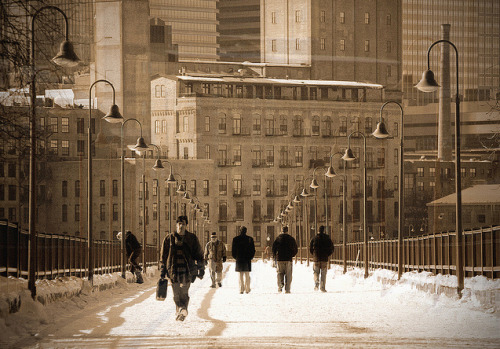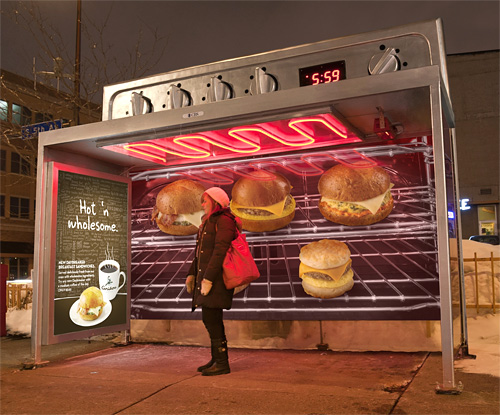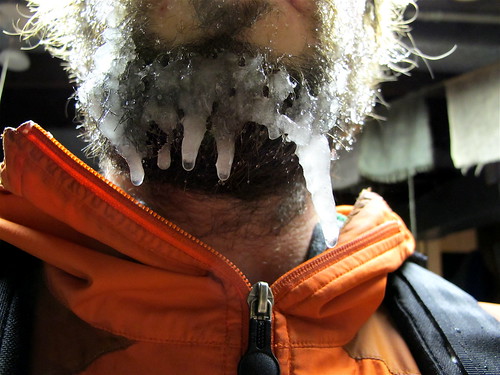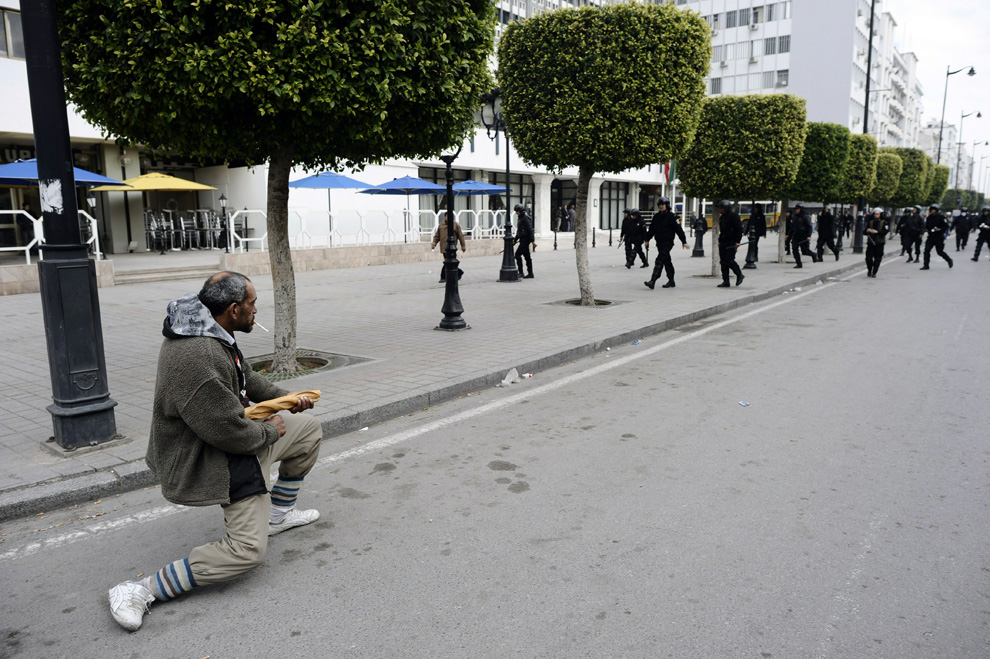 [The "test median" that was installed at the Jefferson and Cleveland intersection from August 24th to September 24th, 2010.]
[The "test median" that was installed at the Jefferson and Cleveland intersection from August 24th to September 24th, 2010.]
6:58pm: I walk up the street toward the
Edgecumbe Recreation Center, thinking I'm going to attend a vital meeting about bicycling in Saint Paul, my home town, thinking I'm going to be attending a meeting that will make or break the future of bicycling in this city, that will help determine whether or not I live in a town that encourages or discourages alternative non-fossil-fueled transportation, that cultivates humane lifestyles, that catalyzes healthy people and healthy lifestyles and healthy cities and communities, that says: "Yes, you can bicycle safely down the street even though you're not a 20-something daredevil, even though you're a mother and maybe overweight and maybe don't feel 100% comfortable on a bike," a city that says everyone is welcome on this street, we're going to take the huge leap of faith and let .1% of our public space be for people NOT in cars, and that's O.K., that's not a revolution (99.9% of car-culture is enough!) and that bike boulevards are not Molotov cocktails thrown haphazardly at SUV dealerships...
I think about this as I walk through the lovely January evening air past the outdoor hockey rink, past the dad teaching his daughter to skate by having her push a metal folding chair, past the sound of hockey sticks slapping down onto the ice, along the snowbank'd sidewalks, down Saint Paul's quiet dark snowy streetlit Griggs Avenue towards the community meeting about bicycling, perhaps the farthest thing from most people's minds in this cold climate...
7:02pm: The room is packed. Somehow the meeting has already started. People are standing near the entrance, collecting there looking lost.
I push my way into a seat near the front, right next to a very concerned looking woman who is currently testifying about parking problems near her home.
As it turns out, the discussion is about adding a restricted permit parking area near a school in Highland Park.
7:05pm: A blonde woman begins complaining about parking enforcement giving tickets during holidays.
7:06pm: The meeting's moderator, who sits along a pair of white plastic tables with about nine other not entirely happy looking people at at the front of the room points out that there shouldn't be any enforcement of parking permit zones on holidays. He does this to no avail.
7:08pm: The committee members at the tables look bedraggled, soft spoken. More than two arms are crossed. As people file into the room, they don't seem to be getting any happier. The atmosphere in the room already seems testy.
7:12pm: Discussion of school parking permit zones comes to an end. It's agreed that someone in the audience (the blond woman?) will start a neighborhood petition to instate a permitted parking zone near the school, at which point the Mac-Groveland Community Council Transportation Committee (MGCCTC) will take up and study the motion, perhaps to recommend it to the city, at which point it will have to go through a number of city council committees. The process seems impossibly lengthy, and its difficult to see anyone receiving short-term satisfaction.
7:14pm: At this point, the moderator “Jay” suggests ending discussion of the parking situation, and further suggests that those concerned might want to leave the meeting to make room for all the bicycle advocates standing in the aisle. This happens. A dozen people leave, a dozen people sit down. Chairs are found, arranged, and sat upon. Now the only people left standing are a group of a half-dozen Macalester students with bike helmets who arrive a bit late to the party. They look lost.
7:16pm: Now comes the moment of truth. We get to the bike boulevard median situation.
Jay makes a great deal about how the meeting today is just to report the findings from a study that was done on the the “test median” at Cleveland and Jefferson. (This is
a long story, and I won't go into it here.) He then introduces two men from the city of Saint Paul public works department, Paul Saint Martin, traffic engineer, and Dave Something (?), traffic engineer. Both are 40-something bearded white men wearing button up shirts with pens in the pockets.
7:17pm: Paul Saint Martin, who seems to be in charge, briefly introduces himself, and then introduces Dave, who does most of the talking.
7:18pm: Dave, wearing brown, ends up pointing to a pair of pages of information that represent the findings of the study, and then goes about explaining them in some engineering-type detail.
He explains that the “test refuge” had two goals. First, it was intended to promote bike and pedestrian activity along the Jefferson bike boulevard, by allowing for an easier crossing of the street at the busy Jefferson and Cleveland intersection.
The second goal, he explains, is to divert through traffic on Jefferson, to reduce the number of cars that are using Jefferson as a through street, to restrict the traffic on that street only to local traffic, i.e. people who actually live there.
 [One of the primary functions of the "test refuge" was to piss off drivers and make them log on to the internet.]
[One of the primary functions of the "test refuge" was to piss off drivers and make them log on to the internet.]Dave then goes to great pains to emphasize that he is just sharing information, and not taking comments. I begin to understand that this meeting is not, in fact, an epic showdown of anti- and pro-bicycling forces meeting in a public arena and struggling to the rhetorical death etc. Rather, it is an objective reporting of facts ascertained by a careful neutral engineering-type study of facts neutral innocent bystander (or something like that).
7:26pm: The details of the study come next, and are delivered in the a dry fashion typical of numbers. You can read them for yourself
here. There are two main components to the study. First, they looked at how the median affected traffic and speeds along Cleveland, Jefferson, and neighboring streets. As it turns out, the refuge didn't affect either very much.
Much to my surprise, average speeds on Cleveland
didn't change more than 1 or 2 mph, and the 85% speed changed even less. (Of course, the median wasn't in fact a true median, and was instead a series of orange plastic things placed in the road. The median refuge had neither very effective calming qualities, nor aesthetic merits, both of which would surely exist with a real
bona fide median. Which goes to show you, IMHO, that this kind of half-assed experimental approach is like "pissing into the wind," so to speak.)
The other part of the study involved gathering comments about the (inelegant and ugly) test median refuge boulevard, and, as you might imagine, many of these comments were negative. The split was about 60 / 40 weighted against the change, which actually to my mind seems pretty good considering its “test” status. Also, for some reason, the comments were then filtered through some sort of address matching process, whereby only those within a ½ mile of the intersection were counted. Also surprisingly, these results were practically identical to the larger sample.
7:36pm: "Jay" the moderator gives the two
Transit for Livable Communities engineers, both 30-40 something men with beards but without glasses, a chance to talk about the test, and Tony Hull, TLC transportation specialist, briefly takes the floor to explain a few things about the concept of bike boulevards in general and this test median in particular. He keeps it very brief.
7:37pm: Now, the denouement! At this point Dave takes questions about the process.
Questions include:
7:38pm: Q:
[older man with white hair] What about snow? The snow makes the street even narrower, and it will be impossible to turn the corner! Have they talked to bus drivers and snow plow drivers? Ambulance drivers? I'm not convinced it will “calm” anything!
A:
[Dave.] Hm. We're talking to the fire department and the snow plow drivers. We might have to tweak the turning radius on the corners.
7:39pm: Q:
[middle-age woman with black hair.] Was there any “due diligence” in counting the number of pedestrians using the median? Is this a good use of taxpayer money?
A:
[Also Dave.] It's a “chicken and egg” kind of thing. Pedestrians and cyclists won't use it until we build it, so we can't wait for more pedestrians to come to justify building a median.
Man from the crowd:
[Helpfully.] I live very close to the median and saw a lot of people using the refuge.
7:41pm: Q:
[Middle-age woman with black hair, a different one.] There was no testing done on the alleys. Many cars are now driving down my alley, and my children play in the alleys. It's dangerous! Also, cars slow down at the median, but then just speed right up near Wellsely Avenue so its even more dangerous because they're speeding!
A:
[Dave: no answer that I can remember.]7:42pm: Q:
[Another black coated woman with black hair.] What about snow removal when it snows a lot like in December when there is 3 feet of snow?
A:
[Sparrows playing violins.]7:43pm: Q:
[Older woman in blue sweatshirt with white hair.] Instead of spending money on the median why not put up a stop sign? That way bikes can blow through it, cars can blow through it, and pedestrians can dance in the street.
A:
[Chuckles pervade the room.]7:45pm: Q:
[Earnest bike-type fellow.] Will there eventually be a similar refuge on Cretin? That street is just as busy.
A:
[Dave again.] Probably, if all goes well, and if the city decides to go through with the project. Cretin is scheduled for re-paving in 2014, and that's when we'd probably do it.
7:47pm: Q:
[Someone.] Are there other plans or ideas that would allow for left turns off Cleveland?
Q: If a neighborhood streeet is one that has less than 500 cars / day (as was mentioned during the earlier wonky part of the presentation), and Jefferson already has less than 500 cars / day, why even bother with all this? Were the speed limit differences statistically significant?
7:50pm: At which point Tony Hull,
TLC transportation and traffic calming guru tries to explain about bike boulevards, about how they involve a series of improvements and changes (e.g. roundabouts) designed to allow for efficient and safe cycling that, if done without also diverting car traffic, may have the opposite effect of increasing rather than decreasing auto traffic on the street, which is why the left-turn diverting medians may in fact be the crucial component of the entire bike boulevard concept..
This answer, however, resembles the waving of a red flag as seen by a bull, or a bucket of chum as smelled by a shark, and people just start to get more upset until Dave, the Saint Paul traffic engineer, diffuses the fracas by saying: “Don't worry. We killed all of those improvements anyway,” which strikes me as the single most absurd moment of the evening, where there is seeming pride taken in the fact that this boulevard would be, all in all, a half-assed attempt. (The half-an-ass approach being typical of Twin Cities state-sponsored cycling infrastructure, the “Minnesotan Way,” so to speak.)
7:52pm: Q: What about the county? Isn't Cleveland Avenue a county state aid highway?
A:
[Dave, proudly.] The county pretty much ignores us, and we can do whatever we want, so that's not a problem.
7:57pm: The meeting comes to a close as one of the Mac-Groveland people tells everyone where they can get more information (
macgrove.org).
8:01pm: As folks start to chat amongst themselves, and as the Macalester students begin to leave, not having any idea what had just happened, we start to chat, and the poor MGCCTC asks us nicely to leave the room as they have other business to attend to and would very much like to go home at Nine. We exit into the hallway where there are many youth and fathers in various states of wearing and not wearing hockey gear, and where it does indeed have that musky dank hockey smell that is a not-totally-displeasing combination of sweat and ice.
Whereupon I chat with folks from the
Saint Paul Bike Coalition about various matters of the day, and someone decides that the city is “kicking the can down the road” and we all agree that the test median was a stupid idea to begin with, that they should, as the Nike ads say, “just do it” rather than dicking around all this time with test signs and websites and orange plastic crap and unnecessarily pissing off car-centric neighbors.
 [Saint Paul's patron saint, Joe Soucheray, purses his wrinkly lips alone in a dim office contemplating ways to run over bicyclists with his SUV while on his way to inspect the tools in his garage.]
[Saint Paul's patron saint, Joe Soucheray, purses his wrinkly lips alone in a dim office contemplating ways to run over bicyclists with his SUV while on his way to inspect the tools in his garage.]Update:More links courtesy of
CTC:
Less interesting recap of same meeting by
Jeff Zayer.
Explanation of project by
Ride Boldly.










